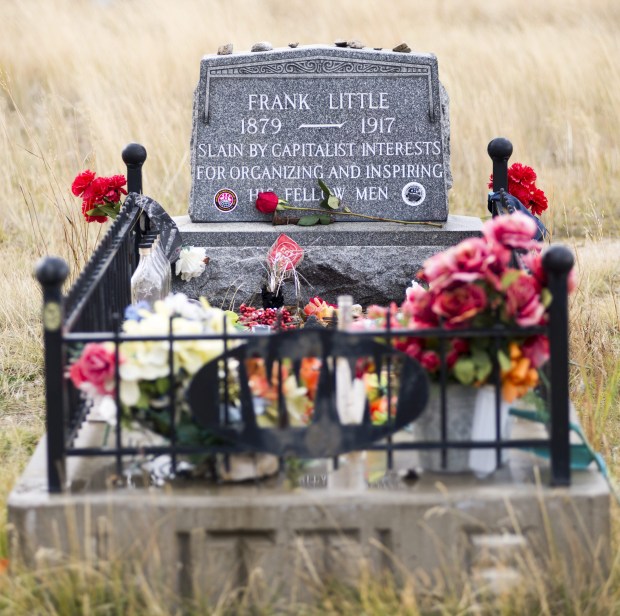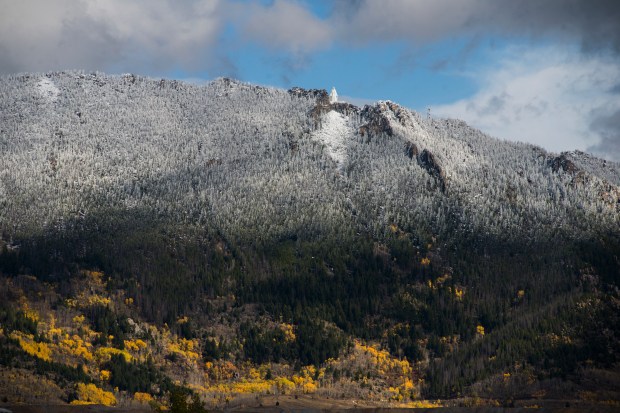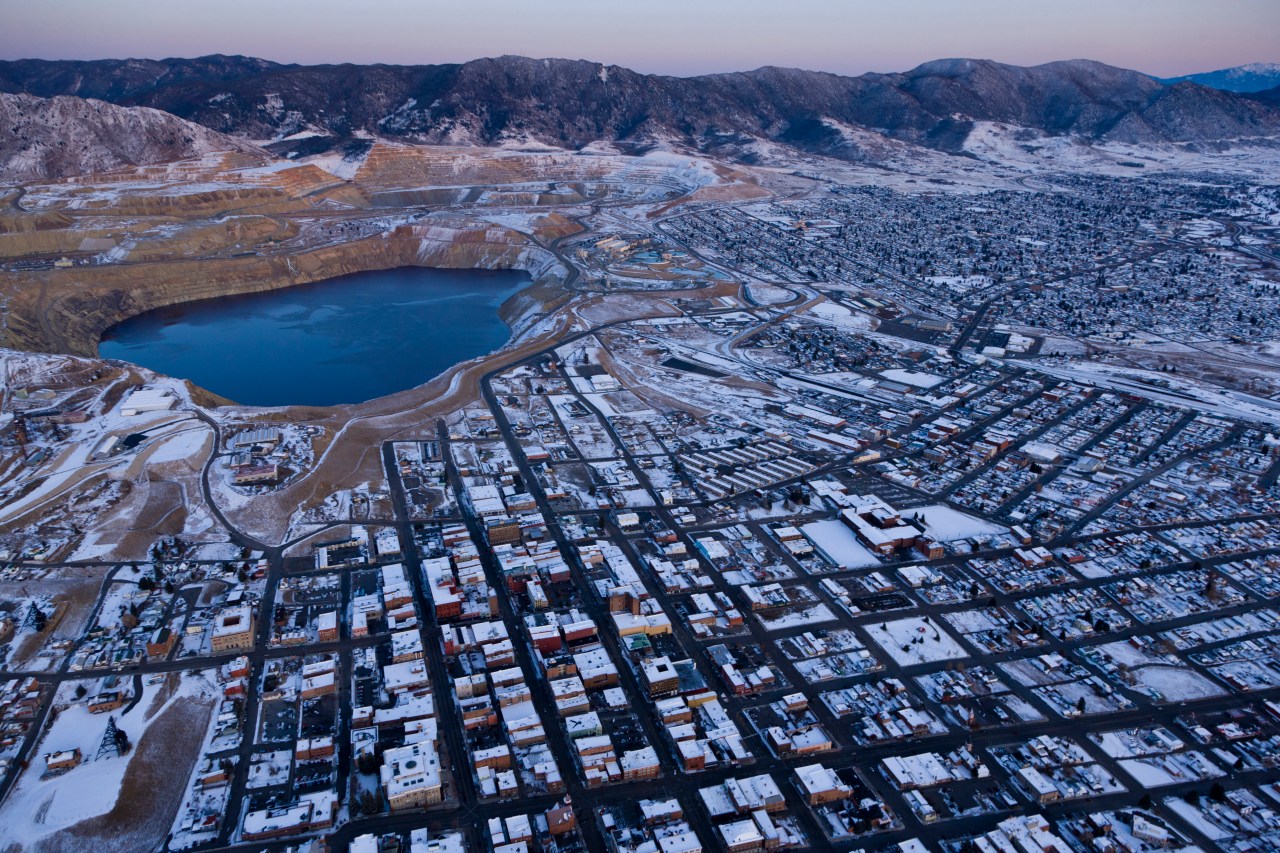A fresh red rose, bunches of chrysanthemums, copper pennies, and live rifle rounds adorn an almost century-old pauper’s grave on a frosty, fall day in Western Montana.
Here lie the bones of radical unionist Frank Little. Here in the weeds of the Mountain View Cemetery, with the gurgling cauldron of the western hemisphere’s largest toxic pit looming in the background, is an example of how the spirit of unionism refuses to die in a place so singular people call it, “Butte, America.”
“It’s easy to spin everything in Butte into the labor story because it has always been all about labor,” says historian Richard I. Gibson, who leads tours of an insurgent new downtown exhibit, the Butte Labor History Center, where visitors have been greeted for two years by a cardboard cutout of Little, eyes straight, lips curled, jaw cocked.

The summer of 2017 in Butte is shaping up to rattle with echoes of the clashes that made 1917 the city’s bloodiest year. For months now, municipal and county leaders have busied themselves planning a suite of events to commemorate the June 8, 1917 hard rock mining disaster that is still the deadliest ever in the U.S. In honor of the estimated 168 victims of a terrible fire deep down a mine shaft on a hill called Granite Mountain, solemn services will be held, colorful flags from the home countries of all the immigrant victims will be raised, and a cadre of Montana musicians will perform new songs about the tragedy in a theatre production entitled, “No Greater Love.”
“We want Butte to sing a duet with the truth of 1917,” said choral conductor and composer Gary Funk.
Longtime resident Gerry Walker, 78, led a campaign to build a fine memorial plaza atop Granite Mountain, and there she is organizing a centennial remembrance ceremony.
“It is important to Butte, in spite of the horror of it all,” she said. “It certainly is something we claim now is in our genes.”
Little, an International Workers of the World leader, was also killed in Butte in the summer of 1917, lynched while rallying miners to fight for their rights after the awful blaze. While some historians and activists in Butte vow that his death will be commemorated too, as of early 2017 city and county officials knew of no definite plans.
That is a confusing move for a city trying to regenerate its economy by marketing its history to tourists. But it is consistent with a civic past in which Gilded Age copper kings and Space Age CEOs controlled the story of Butte by owning newspapers while siphoning away $22 billion in mineral wealth from the middle of town.
“The dominance of the corporations meant that the union story does not get told,” said historian and civic booster Evan Barrett. “Unions have faded out of high levels of consciousness in America, and it has happened here in Butte.”

Floyd Bossard started mining in Butte in 1948 and remembers that among miners, “that feeling of looking after each other translated to the community.” As for the attitude of his bosses, however, he remembers it being typified by one who put him under intense pressure to always dynamite deeper underground, no matter the risk.
“When the men came off shift his question was, ‘Did she blast?’ meaning, ‘Did you break rock and get some production?’” said Bossard, 87, by phone. “Dead work didn’t count with him, [although] dead work meant making the place safer.”
His safety was fought for by Butte Miners Union, No. 1, which vowed to never allow a repeat of the 1917 accident. At that time unions in Butte were buffeted by government demand for copper to fight World War I, and a mandate for ruthless efficiency imposed by William Rockefeller’s Standard Oil trust.
“We were a corporate colony dominated by a single industry,” Barrett explained.
The energy conglomerate Atlantic Richfield Company, a subsidiary of British Petroleum, bought Butte’s open pit mine in 1977 and closed it in 1982. On Earth Day that year the corporation shut off the pumps that kept the Pit dry of rain and snowmelt. Today the only mine left in Butte is also open pit. But as an epilogue for a labor movement that was once so mighty Butte was nicknamed “The Gibraltar of Unionism,” this last mine, a pillar though not a monopolizer of Butte’s new economy, is non-union.
Dump-trucks weighing 240 tons can be seen spiraling out of it from the edge of the poignant memorial plaza built atop Granite Mountain to honor the 1917 victims. The push of a button plays a narrated history complete with sound effects and old-time music. An etched stone reads, “You are standing on hallowed ground.”

No visit to Butte is complete, or even possible, without a look at “the Pit.” It peers 30,000 feet up through airplane windows from its socket in a tawny landscape heaving with snowcapped mountains. If, as western journalist and historian Timothy Egan wrote in 1998, Butte lives today “as a moral at the end of a horror fable,” the role of the monster goes to the Pit.
“I can’t believe this town is living with that hanging over their lives,” said tourist Linda Fowler, 69, a retired chaplain, who paused during her drive on Interstate 90 toward Seattle to pay the $2 fee Butte now has the pluck to charge for a glimpse of its monster.
The mile-and-a-half wide Berkeley Pit was bored 2,000 feet down into the middle of Butte in the 1950s. The Anaconda Copper Company calculated that an open pit mine was more efficient than thousands of miles of underground shafts. The Pit swallowed up entire neighborhoods of clapboard homes. Plans were even drawn in the 1970s to move the municipal building down near the cemetery in anticipation of the Pit eating the entire downtown—now part of America’s largest National Historic District.
But an even bigger mine nationalized in Chile tanked the global price of copper by the early 1980s. Butte’s pit was abandoned. The city suffered an economic collapse and the population crashed from a historic high of more than 100,000 to around 30,000. Then, the Pit began filling with arsenic sludge. It now threatens to overflow into the Clark Fork River, the largest tributary to the Columbia River, which pours into the Pacific Ocean 800 miles away. Today the Pit is the heart of the largest federal superfund site in the U.S.
It is notorious for attracting migrating snow geese that never take off again. Thousands are estimated to have died in it this winter.
“It’s a lot fuller than it used to be and it still looks nasty as ever,” said Anthony Casablanca, 22, a restaurant worker from Butte who snuck his new girlfriend, Kaylee Spencer, 20, to the edge of the abyss for a romantic peek.
“I had to see it,” she said. “It was awesome.”

That Butte could weather such fortunes with swagger and not become a ghost town says everything anybody needs to know about its character, said historian Barrett, who teaches at the University of Montana in Missoula and Montana State University in Bozeman.
“Butte is tough, it’s a town of survivors,” he said over a plate of eggs and sausage at a throwback downtown spot called Gamer’s Cafe. “You talk about the cradle of civilization in Montana—that cradle is here.”
Since the discovery in the late 1800s of what was then the richest vein of copper ever tapped, the tension between the men who risked their money investing in it, and the workers who risked their lives digging it, was explosive.
The Butte Labor History Center shows the labor wars. Since the center opened in 2015 it has drawn hundreds of visitors, some from as far away as England and Germany, said guide Gibson. A highlight is a wall-sized panoramic photo of the Pit in full production in the early 1970s. At its edge are two more residential neighborhoods about to be eaten.
Memories of places lost still haunt Butte. In another repurposed downtown building several new businesses are blossoming due to Butte’s affordability and community loyalty. Headframe Spirits boasts a handsome oak bar, which once shouldered after-shift beers at a watering hole called the Rocky Mountain Cafe in an Italian neighborhood called Meaderville. It went down the Pit in the 1960s.
“My grandmother came in and teared up because she remembered it,” said mixologist Owen Canavan, 29, as he slid a cocktail made of ginger beer and bourbon called a “Montucky” across that bar in a shiny copper cup.

Atop Granite Mountain at the miners’ memorial one of the most magnificent views in Montana spreads out below. The Continental Divide, a mountain range white with fresh snow, and adorned with a 90-foot-tall statue of the Virgin Mary. The Butte skyline studded with church steeples, weathered brick buildings and the occasional Victorian mansion. But on a sparkling October afternoon, several neighbors walk right by. No candle, flag or flower reveals any recent mourner. Two young women from Maryland exploring Butte in a rental car don’t even brake. The only visitor is a small white dog let out of a big pickup with California plates. It lifts a hind leg near another etched stone revealing that money for the plaza came from British Petroleum.
A flame on a foreman’s headlamp touched an oily electric cable 2,400 feet down inside Granite Mountain and sparked the 1917 disaster. A tool sharpener named Manus Duggan and a shift boss named James Moore quickly made men build bulkheads across dead-end shafts to seal themselves inside with a little oxygen not yet poisoned with carbon monoxide. Duggan saved 25 lives. Moore another six. Unfortunately, they both succumbed to the deadly gas.
“You will know your Jim died like a man and his last thought was for his wife that I love better than anyone on earth,” Moore scribbled by dying candlelight.
He and Duggan—whose tombstone reads, “No greater love hath any man than that he shall lay down his life for his friends”—will be remembered as heroes in 2017.
Frank Little rushed in as soon as he learned about the calamity. A revolutionary firebrand spoiling for a fight, Little barnstormed the western U.S., organizing miners, mill workers and farmers. In Butte he prophesied that rapacious corporations would plunder the mineral wealth, discard the workers, and leave the environment ruined.
Just past midnight on Aug. 1, 1917 six masked men kidnapped him from his boardinghouse. They beat him, dragged him behind a car, and lynched him from a railroad bridge. Over the years dozens of people were suspected, but no one was ever charged. Little’s tombstone, pointed to by no sign or map, reads, “Slain by Capitalist Interests for Organizing and Inspiring His Fellow Men.”
He rests next to the poorest victims of the 1917 fire. But his grave stands out because it is blanketed with a lush tapestry of offerings. Cards, caps, pins, stickers and patches reveal that pilgrims found their way here from: Washington, Arizona, Colorado, Wisconsin, Maine, Washington D.C. and France.
That’s a market of history tourists Butte, America can mine, once it better faces its own.